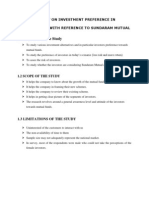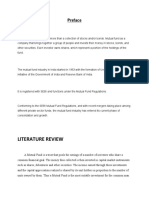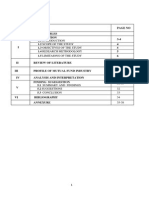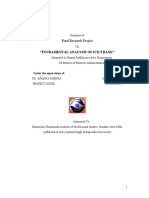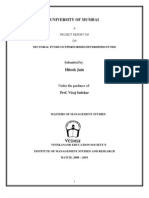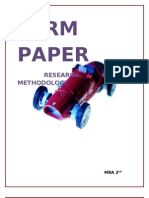Public and Private Sector Mutual Fund in India: Original Article
Public and Private Sector Mutual Fund in India: Original Article
Uploaded by
Gaurav SarkarCopyright:
Available Formats
Public and Private Sector Mutual Fund in India: Original Article
Public and Private Sector Mutual Fund in India: Original Article
Uploaded by
Gaurav SarkarOriginal Title
Copyright
Available Formats
Share this document
Did you find this document useful?
Is this content inappropriate?
Copyright:
Available Formats
Public and Private Sector Mutual Fund in India: Original Article
Public and Private Sector Mutual Fund in India: Original Article
Uploaded by
Gaurav SarkarCopyright:
Available Formats
Tactful Management Research Journal Vol. 2 , Issue.
3 , Dec 2013 ISSN :2319-7943
Impact Factor : 0.119 (GIF) ORIGINAL ARTICLE
PUBLIC AND PRIVATE SECTOR MUTUAL FUND IN INDIA
S.PALANI AND P. CHILAR MOHAMED Assistant prof. of Commerce Swami Dayananda college of Arts & Science Manjakkudi Associate Prof. & Research Advisor of Commerce Khadir Mohideen College Adirampatinam.
Abstract: Development of capital market in a country is an important prerequisite, which only would enable industrial development, business growth and there by contributions towards economic development, without any doubt it could be stated that economic development, measured in the form of growth in GDP or NNP is one of the objectives of every country in the world. A well integrated Financial System alone could hasten economic growth, which it does through channelizing productive resources towards industrial growth and development. In the present days it could be emphatically stated that finance is a very important resources for industrial development. Hence mobilization and utilization of finance take a prime position in the list of priorities for the agenda of economic growth. KEYWORDS: Public , economic development , Private Sector , channelizing productive . INTRODUCTION A well defined Financial System would comprise of three segments. They are lending institution, borrowing institutions, and more importantly the third, which are the financial intermediates. It is an accepted fact that the efficiency of the financial intermediaries would to a very great extent determine the efficiency of the Financial System. REVIEW OF LITERATURE The performance evaluation of managed portfolio has been a widely debated issue in the area of Finance. Harry Markowitz was among the earliest to have stressed the importance of portfolio, it as construction and evaluation Fama, Shape, Treynor who developed and perfected methods and measures and Jensen, were all his followers whose contributions are still being considered path breaking. These contributions were well received, appreciated and acknowledged both by academicians and practioners as well subsequent studies crystalized discussion on the subject with added refinement, up gradation, and innovations in methodology, which substantially reduced quantum of data input required for performances appraisal of managed portfolios. It is commonly believed that empirical evidence on mutual fund performance confirms the original version of the efficient market theory and that expenditure on research and analysis is wasted in such a market where prevailing security prices contain the impact of all information. This impression is attributable to two studies by Sharpe and Jensen (1960) which showed that mutual fund underperformed common market indices. Taken as a whole the results based on these studies are contradictory in the sense that some supported efficient market theory. While other were fund to be consistent with the hypothesis that funds and expenses are wasted. Simonson (1972) noted that mutual fund had shown consistent shift toward speculative investment polices overtime. The concern over this shift in behavior stemmed from the risk, which
Please cite this Article as : S.PALANI AND P. CHILAR MOHAMED , PUBLIC AND PRIVATE SECTOR MUTUAL FUND IN INDIA : Tactful Management Research Journal (Dec ; 2013)
PUBLIC AND PRIVATE SECTOR MUTUAL FUND IN INDIA
attended apparently the disposition of fund managers to strive for quick gains from short-term extrinsic of securities. The study identified the measure of systematic skewness explaining alleged shift among mutual funds towards more highly aggressive investment policies and apparent increase in diversity of investment policies from fund to fund over times. Williamson (1972) made a comparison of rankings of 180 funds over the period 1961 65 with their ranking over the subsequent five year time period 1966 70. The absence of correlation between rankings over the two periods for the entire group of 180 funds was consistent with the identical investment ability of most of the fund manager. The study has also highlighted growing prominence of volatility in the measurement of investment risk. The information of Unit Trust of India marked the evolution of the Indian mutual fund industry in the year 1963. The primary objective at that time was to attract the small investor and it was made possible through the collective efforts of the government of India and the reserve bank of India. SIGNIFICANCE OF THE MUTUAL FUNDS With the emphasis on increase in domestic saving and improvement in deployment of investment through markets, the need and scope for mutual fund operations has increased tremendously. The innovative contents with which mutual funds have been offered make the investor confident that product differentiation will reach the various income segments, geographical segments and risk bearing segments of investor. NEEDS OF THE MUTUAL FUNDS In a society, we have different types of investors who would like to earn a higher return for their meager savings. Opportunities must be provided to such types of investors, consisting of pensioners, middle income group people, etc. They cannot afford to directly invest in companies shares for lack of knowledge and they are quite averse to taking risks. Keeping such factors in mind, investment companies in India like the unit trust of India, promoted mutual funds by which they attract the savings of lower and middle income group people and give them the benefit of corporate profits by distributing attractive dividends at the end of the year. Mutual funds also cater to different types of customers, who are interested in. Fixed income (or) Higher return for investment (or) Who are 'growth oriented' As mutual funds fulfill all these requirements they have not only come to stay but are growing too. The Government has also felt the need for regulating their activities through proper legislation. OBJECTIVES AND HYPOTHESES The specific objectives of the study are: 1.To given overview of the mutual funds and their role in the Indian Financial Market. 2.To assess the performance of the mutual fund schemes in terms of their returns and risk. 3.To applying models developed and tested by recognized experts in the filed and assessing performance of the selected schemes. 4.To compare the performance of various schemes, sector wise viz, public sector funds and private sector funds and also scheme objectives wise viz growth income, and balanced. 5.To segregate the total returns and total risk into their components in order identify area requiring improvement if any. 6.To assess the times ability of the fund manager's performance SCOPE FOR THE STUDY The study encompasses an evaluation of the functioning of public sector and private sector mutual funds. The private sector mutual funds commenced their operational only by the end of the year 1993, where as the public sector had an early start as early as 1964. Since then, mutual funds industry has been facing lot of challenges and strides. This promoted the researcher to compare the performances of the mutual funds sector. Performance has many facts to be looked into like operational efficiency in terms of return and risk as well as cost of operation, sales efficiency investor services, practices in the area of investment policies and pattern as well as disclosure policies.
Tactful Management Research Journal Volume 2 Issue 3 Dec 2013
PUBLIC AND PRIVATE SECTOR MUTUAL FUND IN INDIA
STATEMENT OF PROBLEM Mutual funds pool the funds of small investor and invest it in the securities. As the investors do not know in which portfolio the fund managers will go investment, the performance such as the risk and the return associated with each fund type will only affect the investor. Here the risk associated with each type will vary, hence the return wil also vary. Since the investors are investing based on the scheme category such as private or public sector funds. Costs are the biggest problems with mutual funds. These costs eat into our return and they are the main reason why the majority of funds reason why the majority of funds end up with sub par performance. Some cities of the industry say that mutual funds companies get away with the fees they charges only the average investor does not understand what he/she is paying for: fees can be broken allow into two catogories. 1.On going yearly fees to keep is invested in the fund. 2.Transaction fees paid when we buy or sell shares in a fund. RESEARCH METHODOLOGY STATISTICAL TOOLS The study will be empirical in nature and mainly based on secondary data. The main source of data will be the documents and the annual reports of the various mutual fund and schemes and also the net asset values (NAVs,) resale prices and repurchase prices announced by the funds from time to time. The necessary market price information will be collected from the centre for monitoring Indian Economy, (CMIE) monthly reports, dallies like. The Hindu Business line, The Economic Times and AMFI (Association of mutual fund industry) new scatters. The relevant literature will be collected from books, journals and magazines. The collected data were analyzed and the performance was measured. Portfolio performance was measured mostly in terms of returns in early days, though there was an awareness of the concept of risk, which was difficult to quantify. Risk could not be incorporated in evolution, as there was no measures that combined both return and risk. Returns on portfolio performance are Sharpe Ratio, Try nor measure and Jensen measure. These are absolute measure of portfolio performance that can be used to rank different portfolios. Return For each mutual fund scheme under study, the monthly returns ae computed as:
Ri = NAVt NAVt-1 NAVt-1
Average
R =? Ri/n
I=1,2,3.....................n
Risk Standard deviation : Measurement of Total Risk Financial analysts and statisticians prefer to use a quantitative risk surrogate called the clash of returns, denoted by l. The standard deviation and he variance are equally acceptable and equivalent quantitative measures of an asset's total risk. The variance and standard deviation are computed from logarithmic monthly returns.
I = [? (Ri R)2 / n]1/2
Beta Measurement of Systematic Risk To obtain the measure of systematic risk (Beta) of the mutual fund scheme, Market model is applied.
Tactful Management Research Journal Volume 2 Issue 3 Dec 2013
PUBLIC AND PRIVATE SECTOR MUTUAL FUND IN INDIA
=N? XY-E? ? Y
N? X2- (? X)2
RISK-LESS ASSET By definition, a risk less asset has zero variability of returns. If an investor buys an asset at the beginning of the holding period with the known terminal value, such types of asset can be called as risk-less or risk free asset. Government securities and nationalized bank deposits fall under this category. As the government securities are not easily available to the common man, we take the nationalized bank deposits as the risk free asset and the interest rate on such deposits are considered as risk free return. RESULTS AND DISCUSSION The performance of private mutual funds in India has been very encouraging. Sensing this, some of the foreign companies such as Morgan Stanley showed interest to promote the mutual funds in India. The performance of private mutual funds can be judged on the following basis. Funds mobilized over the years Number of schemes promoted NAV of these units Profits earned over the years ACHIEVEMENTS Among the top 5 stock brokers in India (4% of NSE volumes) India's No. 1 Registrar & Securities Transfer Agents Among the to top 3 Depository Participants Largest Network of Branches & Business Associates ISO 9002 Certified operations by DNV Among top 10 Investment bankers Largest Distributor of Financial Products Adjudged as one of the top 50 IT uses in India by MIS Asia Full Fledged IT driven operations. FINDINGS The ability of the portfolio manager to minimize the amount of insurable risk. Incase of Security fund LIC MF govt. security fund showed increase in performance based on both Sharpe ratio under the period of analysis. Incase of mutual plan Reliance retail plan showed increase in performance based on both trey nor ratio under the period of analysis. Investors treat their holdings like rented goods. Most of the investors ignore the long-term periods. Economic moat prevents competitors from stealing market share. Bond/income fund is to provide a steady cash flow to investors. RECOMMENDATIONS / SUGGESTIONS Investors should know about the basic elements of mutual fund. Investors should choose their risk level and according to that they has to choose the funds. Investors should analyze the company performance and then invest the funds. Investors should wait for the long-term returns. Effects of differential degrees of risk on the return of the portfolios must be taken into account. CONCLUSION 1.Almost all studies had adopted variance in the returns as a measure of risk. 2.Factors considered as relevant in performance evaluation of mutual fund will be returns, risk market returns, market risk measured as b unique risk, diversification, selectivity, timing managerial
Tactful Management Research Journal Volume 2 Issue 3 Dec 2013
PUBLIC AND PRIVATE SECTOR MUTUAL FUND IN INDIA
computation expenses of management, load factors. 3.Risk measures were more appropriate when the internal in which the returns were calculated was shorter than those for which it. REFERENCE L.M. Pandey, (1977), Financial management, Vikas Publishing House Pvt. Ltd., Vol.26, New Delhi. C.R. Kothari, (1985), Research Methodology, New Age International (P) Limited, Publishers, New Delhi.
Tactful Management Research Journal Volume 2 Issue 3 Dec 2013
You might also like
- Chapter IDocument83 pagesChapter IAruna TalapatiNo ratings yet
- Introduction of RSD Sem IIDocument4 pagesIntroduction of RSD Sem IIop bolte broNo ratings yet
- Volume 4 No 1 Article 9Document14 pagesVolume 4 No 1 Article 9Vengatesh SlNo ratings yet
- Vipparthi and MargamDocument12 pagesVipparthi and MargamUpender Kumar100% (1)
- AbcdyhhjDocument64 pagesAbcdyhhjAruna TalapatiNo ratings yet
- Mutual FundsDocument43 pagesMutual Fundsarjunmba119624100% (1)
- Raja Main ProjectDocument8 pagesRaja Main Projectrajamba02No ratings yet
- LinkDocument25 pagesLinkchandan chNo ratings yet
- Review Literature - 01 (12 Files Merged)Document12 pagesReview Literature - 01 (12 Files Merged)Obaid AhmedNo ratings yet
- EvolutionofMFinIndia PaperDocument22 pagesEvolutionofMFinIndia PaperrodpalkarNo ratings yet
- A Study On Investor's Perception About Mutual FundsDocument6 pagesA Study On Investor's Perception About Mutual FundsRavi SharmaNo ratings yet
- Behavioural Analysis of Individual Investors Towards Selection of Mutual Fund Schemes: An Empirical StudyDocument7 pagesBehavioural Analysis of Individual Investors Towards Selection of Mutual Fund Schemes: An Empirical StudyAlphonseGeorgeNo ratings yet
- BILALDocument105 pagesBILALrahulprajapNo ratings yet
- EvolutionofMFinIndia PaperDocument22 pagesEvolutionofMFinIndia PaperSindhuNo ratings yet
- Ap19 PDFDocument9 pagesAp19 PDFAnuradhaNo ratings yet
- Study of Sector Wise Allocation of Selected Schemes of ELSS Mutual FundsDocument9 pagesStudy of Sector Wise Allocation of Selected Schemes of ELSS Mutual FundsAnuradhaNo ratings yet
- An Empirical Study On Performance of Mutual Funds in IndiaDocument5 pagesAn Empirical Study On Performance of Mutual Funds in Indiaanon_336382763No ratings yet
- 6 KJ 2Document9 pages6 KJ 2Tanmay ChopraNo ratings yet
- Microsoft Word Synopis A Study On Import Export ServiceDocument15 pagesMicrosoft Word Synopis A Study On Import Export Serviceakansha2524No ratings yet
- A Report ON: Mutual Fund Industry in IndiaDocument8 pagesA Report ON: Mutual Fund Industry in IndiasanjeevNo ratings yet
- Chapter-I Introduction To Mutual FundsDocument55 pagesChapter-I Introduction To Mutual FundsBaba FakruddinNo ratings yet
- Dissertation Report On Reliance Mutual FundDocument8 pagesDissertation Report On Reliance Mutual FundWriteMyPapersDiscountCodeCleveland100% (1)
- A Comparative Analysis of Mutual Funds in Private Sector Bank & Public Sector BankDocument84 pagesA Comparative Analysis of Mutual Funds in Private Sector Bank & Public Sector BankSami Zama0% (1)
- Literature Review: PrefaceDocument8 pagesLiterature Review: PrefaceBhashkarjoshiNo ratings yet
- Sno. Particulars Pageno 1 Summary of The Project 1 2 2 3 Objective of The Project 2 4 Literature Survey 3 5 Methodology 3 6 Time Activity Chart 3Document4 pagesSno. Particulars Pageno 1 Summary of The Project 1 2 2 3 Objective of The Project 2 4 Literature Survey 3 5 Methodology 3 6 Time Activity Chart 3sudhakar kethanaNo ratings yet
- Project On Mutual FundsDocument39 pagesProject On Mutual FundsprasadradhakrishnanNo ratings yet
- Sudhir Final Doc (1) (Autosaved) NEWDocument45 pagesSudhir Final Doc (1) (Autosaved) NEWArvindsingh1857gmailNo ratings yet
- Mutual FundsDocument11 pagesMutual FundsTapan JariwalaNo ratings yet
- Naseem Fara Rv. S1feDocument11 pagesNaseem Fara Rv. S1feAnsaf AzeezNo ratings yet
- A Synopsis Report ON Mutual Funds AT Hdfcbank LTD: Submitted byDocument16 pagesA Synopsis Report ON Mutual Funds AT Hdfcbank LTD: Submitted byMohmmedKhayyumNo ratings yet
- Chapter No.1Document41 pagesChapter No.1ffNo ratings yet
- An Empirical Study On Indian Mutual Funds Equity Diversified Growth Schemes" and Their Performance EvaluationDocument18 pagesAn Empirical Study On Indian Mutual Funds Equity Diversified Growth Schemes" and Their Performance Evaluationkanwal12345hudaatNo ratings yet
- 10 Chapter 3Document23 pages10 Chapter 3Chhaya ThakorNo ratings yet
- Investor Perception About Systematic Investment Plan (SIP) Plan: An Alternative Investment StrategyDocument7 pagesInvestor Perception About Systematic Investment Plan (SIP) Plan: An Alternative Investment StrategyUma Maheswar KNo ratings yet
- Master Thesis (Chap 1)Document16 pagesMaster Thesis (Chap 1)Nishan V JainNo ratings yet
- Synopsis On: Submitted in Partial Fulfilment of The Award of The Degree ofDocument7 pagesSynopsis On: Submitted in Partial Fulfilment of The Award of The Degree ofMahaveer ChoudharyNo ratings yet
- Executive SummaryDocument94 pagesExecutive SummarymurrariNo ratings yet
- Analysis of Investment Pattern of Mutual Funds Investors - An Empirical Study in OrissaDocument22 pagesAnalysis of Investment Pattern of Mutual Funds Investors - An Empirical Study in OrissaPrakash KumarNo ratings yet
- Mutual Fund Project LLM2Document122 pagesMutual Fund Project LLM2Adv Moumita Dey BhuwalkaNo ratings yet
- RelianceDocument78 pagesRelianceSurinder KumarNo ratings yet
- Test of Sharpe Ratio On Selected Mutual Fund SchemesDocument10 pagesTest of Sharpe Ratio On Selected Mutual Fund SchemesPritam ChandaNo ratings yet
- Sectoral Funds Outperformed Diversified FundsDocument21 pagesSectoral Funds Outperformed Diversified FundsMalathi KuttyNo ratings yet
- JMRA - Vol 2 (1) - 1-23Document23 pagesJMRA - Vol 2 (1) - 1-23Yashika TpNo ratings yet
- Investors' Perceptions of Mutual Fund Risks An Empirical StudyDocument7 pagesInvestors' Perceptions of Mutual Fund Risks An Empirical StudySumeet SharmaNo ratings yet
- Thesis (Mutual Fund) 1Document44 pagesThesis (Mutual Fund) 1gauravnafria2010100% (1)
- A Study On Different Mutual Funds Providers in IndiaDocument121 pagesA Study On Different Mutual Funds Providers in IndiaRajesh BathulaNo ratings yet
- 2 Ijhrmroct20192Document14 pages2 Ijhrmroct20192TJPRC PublicationsNo ratings yet
- InterimDocument32 pagesInterimmanku88No ratings yet
- Summer Training Report On Anand RathiDocument97 pagesSummer Training Report On Anand Rathirahulsogani123No ratings yet
- Bhavesh - Mutual FundsDocument30 pagesBhavesh - Mutual FundsBhavesh PopatNo ratings yet
- Mutual FundDocument80 pagesMutual Fundjignas cyberNo ratings yet
- 18-CAPITALASSETPRICINGMODELITSRELIABILITYDURINGDOWNTRENDSINSTOCKMARKETS - CopyDocument15 pages18-CAPITALASSETPRICINGMODELITSRELIABILITYDURINGDOWNTRENDSINSTOCKMARKETS - CopysavitaNo ratings yet
- Literature Review of Mutual Funds in IndiaDocument4 pagesLiterature Review of Mutual Funds in Indiaanu0% (2)
- International Journal of Management (Ijm) : ©iaemeDocument6 pagesInternational Journal of Management (Ijm) : ©iaemeIAEME PublicationNo ratings yet
- Review of LiteratureDocument12 pagesReview of LiteratureRanjit Superanjit100% (1)
- Comparative Analysis On Mutual Fund Scheme Ijariie7162Document15 pagesComparative Analysis On Mutual Fund Scheme Ijariie7162298Harsh VadaliyaNo ratings yet
- Term Paper: Research MethodologyDocument21 pagesTerm Paper: Research MethodologyPUNTERPVTLTDNo ratings yet
- 03 - Literature ReviewDocument12 pages03 - Literature ReviewObaid AhmedNo ratings yet
- Indian Stock Market and Investors StrategyFrom EverandIndian Stock Market and Investors StrategyRating: 3.5 out of 5 stars3.5/5 (3)






